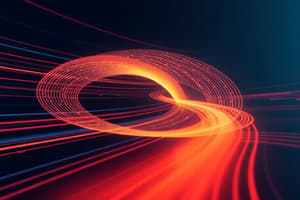Podcast
Questions and Answers
What is the term for the distance an object travels from its initial to its final position?
What is the term for the distance an object travels from its initial to its final position?
- Displacement (correct)
- Velocity
- Speed
- Acceleration
What is the rate of change of distance with time?
What is the rate of change of distance with time?
- Displacement
- Acceleration
- Velocity
- Speed (correct)
What is the equation of motion that describes the relationship between velocity, initial velocity, acceleration, and time?
What is the equation of motion that describes the relationship between velocity, initial velocity, acceleration, and time?
- d = st
- a = Δv / Δt
- s = ut + (1/2)at^2
- v = u + at (correct)
What type of motion is characterized by a constant velocity?
What type of motion is characterized by a constant velocity?
What does a curved line on a distance-time graph indicate?
What does a curved line on a distance-time graph indicate?
What is the term for the rate of change of displacement with time?
What is the term for the rate of change of displacement with time?
Flashcards are hidden until you start studying
Study Notes
Motion in a Straight Line
Definition
- Motion in a straight line is also known as rectilinear motion
- It occurs when an object moves in a single direction along a straight line
Key Concepts
- Displacement: The distance an object travels from its initial to its final position
- Distance: The total length of the path traveled by an object
- Speed: The rate of change of distance with time
- Velocity: The rate of change of displacement with time
Kinematic Equations
- v = u + at: The equation of motion, where:
- v = final velocity
- u = initial velocity
- a = acceleration
- t = time
- s = ut + (1/2)at^2: The equation of motion, where:
- s = displacement
- u = initial velocity
- a = acceleration
- t = time
Graphical Analysis
- Distance-Time Graphs:
- A straight line indicates uniform motion
- A curved line indicates non-uniform motion
- Velocity-Time Graphs:
- A straight line indicates uniform acceleration
- A curved line indicates non-uniform acceleration
Types of Motion
- Uniform Motion: An object moves with a constant velocity
- Non-Uniform Motion: An object moves with a changing velocity
- Accelerated Motion: An object moves with a changing velocity, resulting in acceleration
Motion in a Straight Line
Definition and Types of Motion
- Motion in a straight line, also known as rectilinear motion, occurs when an object moves in a single direction along a straight line
- Types of motion include Uniform Motion, Non-Uniform Motion, and Accelerated Motion
Key Concepts
- Displacement: the distance an object travels from its initial to its final position
- Distance: the total length of the path traveled by an object
- Speed: the rate of change of distance with time
- Velocity: the rate of change of displacement with time
Kinematic Equations
- v = u + at: the equation of motion, relating final velocity, initial velocity, acceleration, and time
- s = ut + (1/2)at^2: the equation of motion, relating displacement, initial velocity, acceleration, and time
Graphical Analysis
- Distance-Time Graphs: • A straight line indicates uniform motion • A curved line indicates non-uniform motion
- Velocity-Time Graphs: • A straight line indicates uniform acceleration • A curved line indicates non-uniform acceleration
Studying That Suits You
Use AI to generate personalized quizzes and flashcards to suit your learning preferences.




